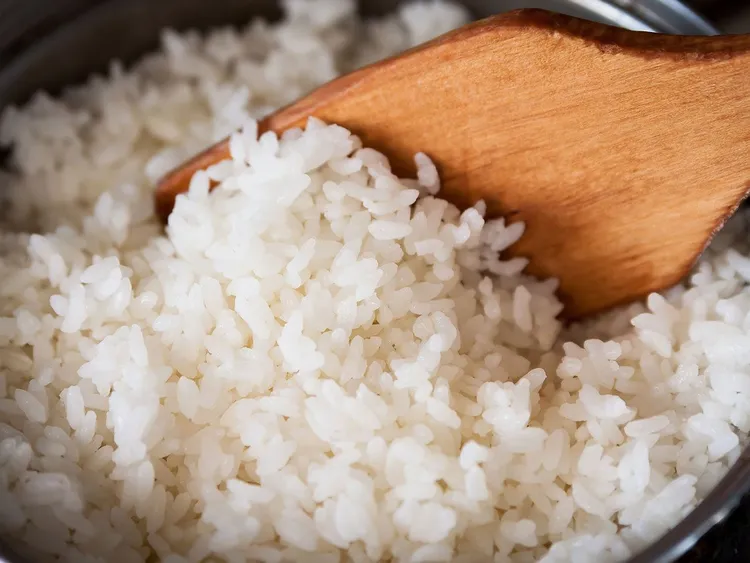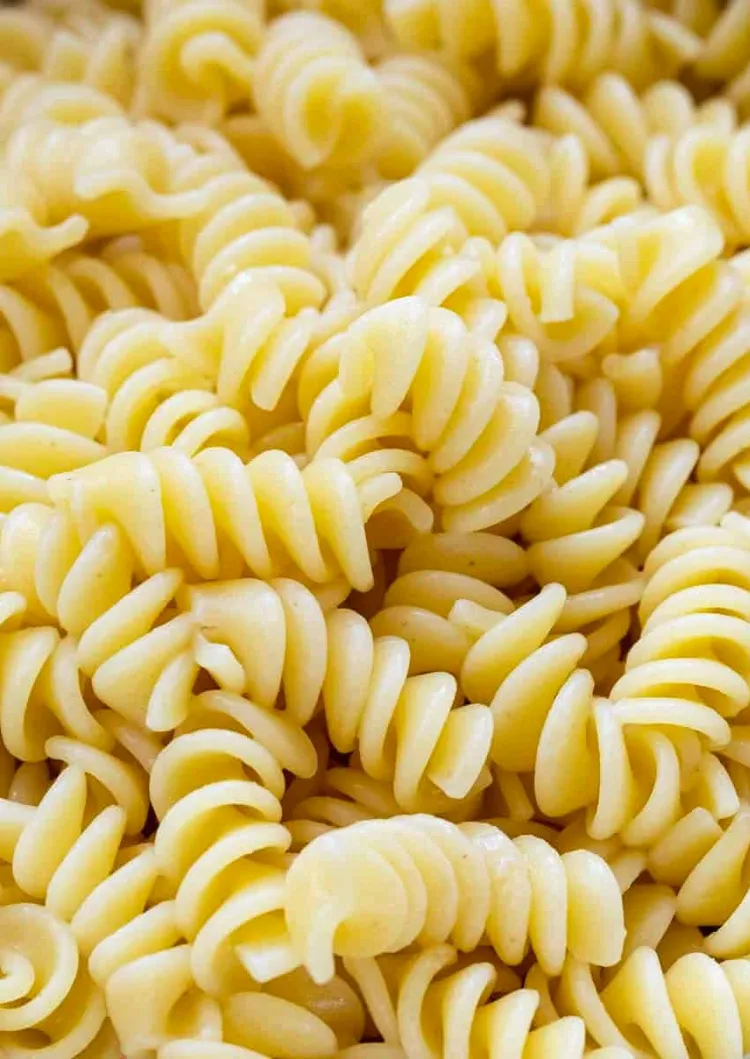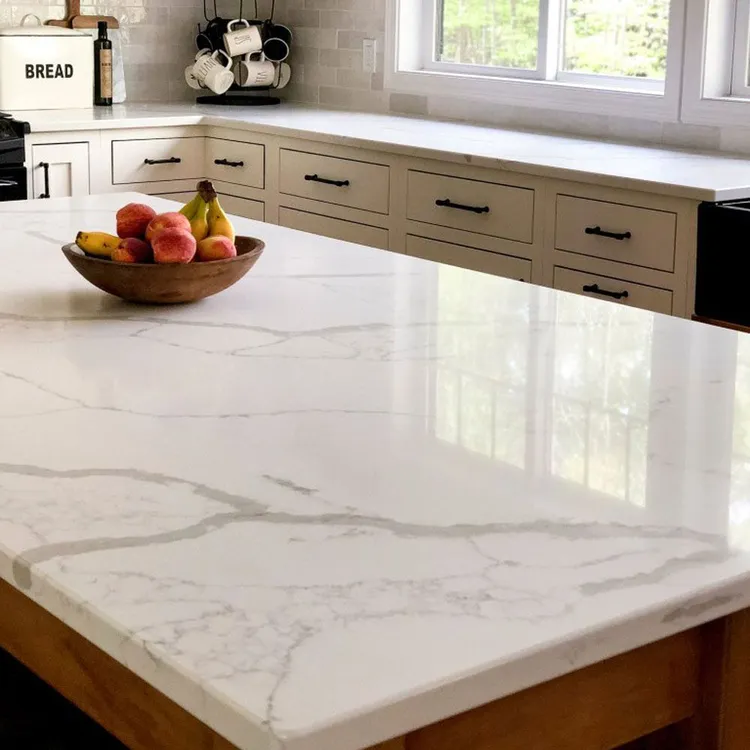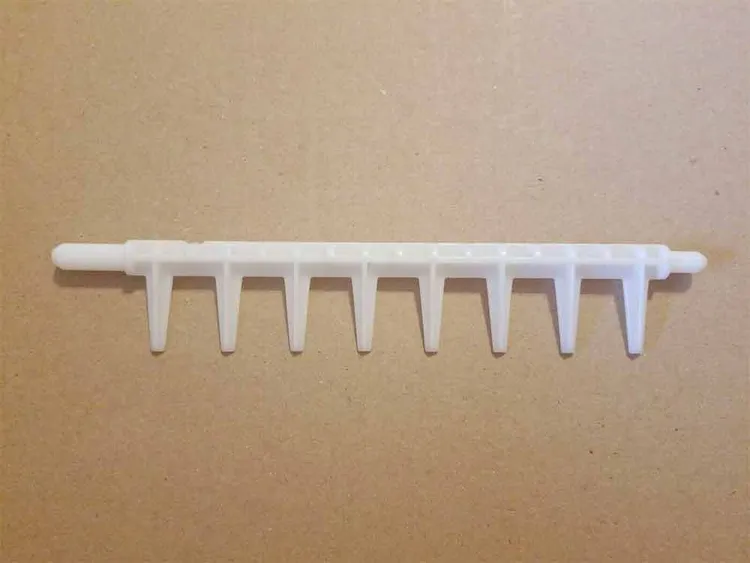Our recommendations are made independently through Research & Testing. We may receive commissions from purchases made via our links.
How to Clean a Cutting Board: A Complete Guide
Got unsightly stains on your cutting board? This guide can help you learn how to clean a cutting board, no matter the material it’s made from.
A cutting board is an indispensable tool for any recipe, whether for processing meat, dicing up fruits for a salad bowl, or preparing vegetables.
But as versatile as it is, a cutting board requires a special amount of care and attention for this exact reason. The oft-used surface is a fertile ground for bacteria that can cause serious health issues via cross-contamination. Furthermore, cutting boards can wear down quickly due to regular use.
Knowing exactly how to clean cutting boards will allow you to prepare food safer, healthier, and save you money in the long run on new cutting boards, too.
How to Clean a Cutting Board After Use
To keep your cutting board in the best health possible, you should make a habit of cleaning it every time you finish using it. Fortunately, it’s quite simple and isn’t all that different from rinsing dishes.
- Give the board a brief rinse under running water. Make sure the majority of the debris or stuck-on gunk is washed off.
- Let the cutting board soak in a container of soapy water for about 5 minutes. You can use ordinary dish soap, but it’s best to use antimicrobial dish soap.
- Scrub the surface with a sponge. Give special attention to scuff marks, knife cuts, and other dents on your board’s surface. These are the places where bacteria and food bits often collect.
- Wipe the board using a clean, dry cloth and let it air dry.
Depending on how frequently you use your board, deep clean once or twice a week.

Board Materials
Proper cleaning techniques vary depending on your cutting board’s material. While most people are familiar with the wooden and plastic variants, many cutting boards are made from more exotic materials.
Composite cutting boards, for example, are a pretty recent addition to the market. Made from high-quality resin, they are more durable. They are also capable of withstanding higher temperatures than boards made from other materials (up to 250°F) without warping. And unlike traditional cutting boards, they require far less maintenance and typically only need a rinse under the tap.
With some research, you can also find many cutting boards made from glass, marble, or stainless steel. As expected, none of these materials can be cleaned with the same procedures used on normal plastic or wooden cutting boards.
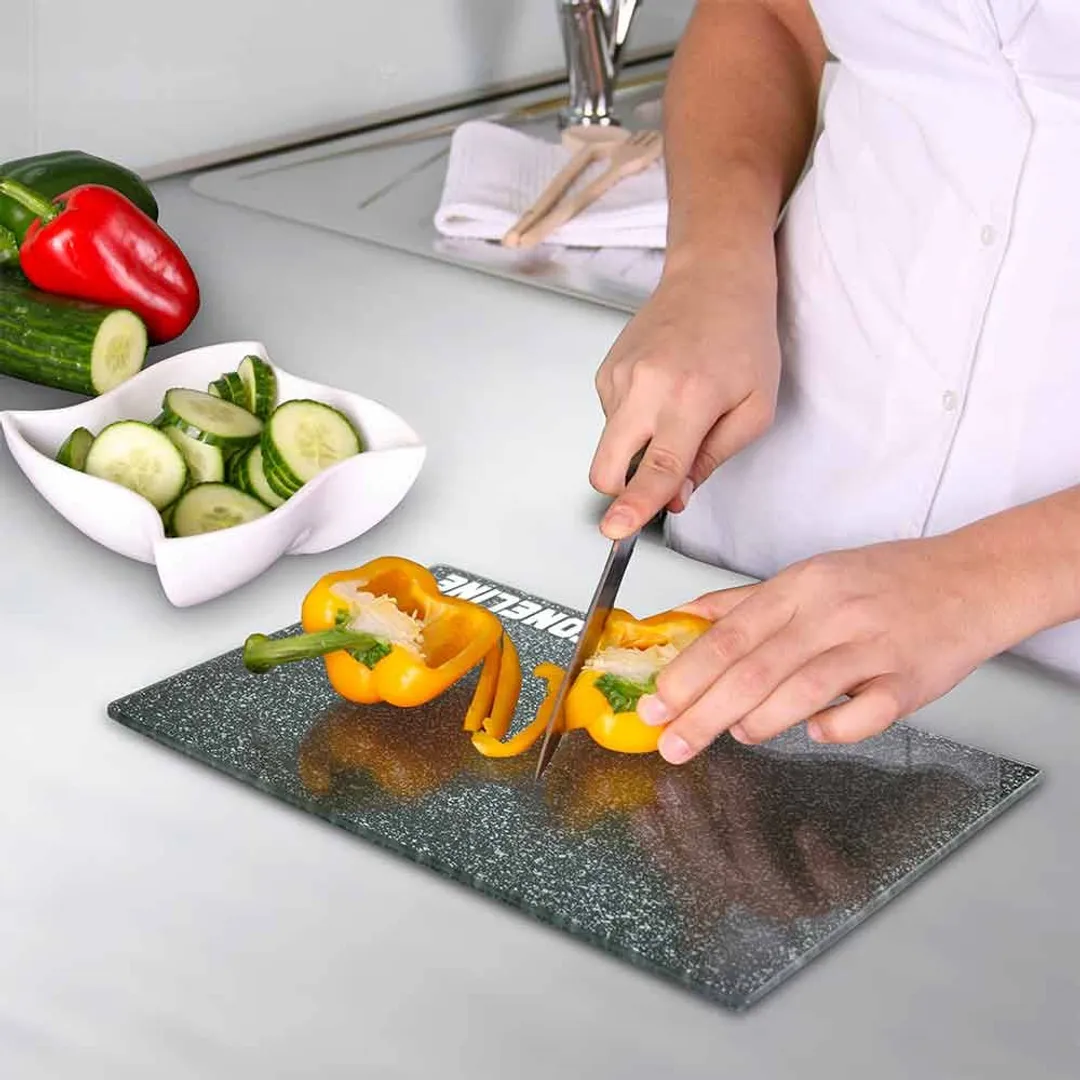
How to Clean a Wooden Board
The Basics About Wooden Cutting Boards
A wooden cutting board can be made from a vast selection of wood, including, but limited to oak, beech, maple, teak, and bamboo. With a passing glance, all of them may look the same, but each kind of wood actually has different properties. You have to be aware of every one to be able to clean your board effectively and safely.
It’s also for this reason that wooden boards are considered the fussiest type to clean and maintain.
Hardness
Maple cutting boards, for example, are harder than beech and teak. On the Janka hardness scale, maple scores 1,450 lbf compared to the other two, 1,300 lbf and 1,070 lbf, respectively. Because of this, maple is less susceptible to scratches. Thus, if your board collects food debris after a while, you can scrub with a sponge more vigorously knowing you won’t damage the surface.
Porosity
Closed-grain woods like maple and beech have very small pores that are nearly invisible to the naked eye. Thanks to this, they’re more resistant to water logging and stains.
Open-grained boards soak up water they come into contact with, so they’re more likely to warp, crack, or shrink when the wood fibers naturally expand from all the moisture.
As a result, a cutting board with a low liquid absorption rate is highly desirable from a maintenance perspective. It makes cleaning less of a chore since you can be more liberal with the amount of water you use to clean it.
Bacterial Growths
Bacteria can infiltrate a cutting board through the wood’s pores. Inside the wood’s meat, they can grow undisturbed and contaminate the ingredients you put on the board’s surface. Because closed-grain woods can naturally resist bacterial growths with their smaller pores, they require less meticulous maintenance to keep sanitized.
Toxicity
When you slice into the wood or strike the board with your knife, a small amount of wood dust is flung up. While a little dust typically doesn’t hurt, for some people, it can create a pretty strong reaction.
In some individuals, touching or breathing in the dust of certain types of wood can cause contact dermatitis, respiratory issues, irritations, and worsen asthma. Many wood types have been reported to cause violent reactions like fainting, insomnia, and greater chances of developing nasal cancer.
The majority of cutting boards made from common woods like maple and oak are perfectly safe to use. But, like we mentioned before, wooden cutting boards can be made from a very wide range of woods, including those that are rarer and more exotic. Some of these can induce the aforementioned symptoms in susceptible people.
For example, Purpleheart wood, while beautiful with its unique violet coloring, can cause irritation and nausea if you’re exposed to its dust. Its natural toxins could also potentially leak into your food.
Overall, just stick to the tried-and-true woods and steer clear of the more exotic types regardless of how beautiful they are. Or, at the very least, if you’re insistent on using such a board, do the requisite research on its toxicity.
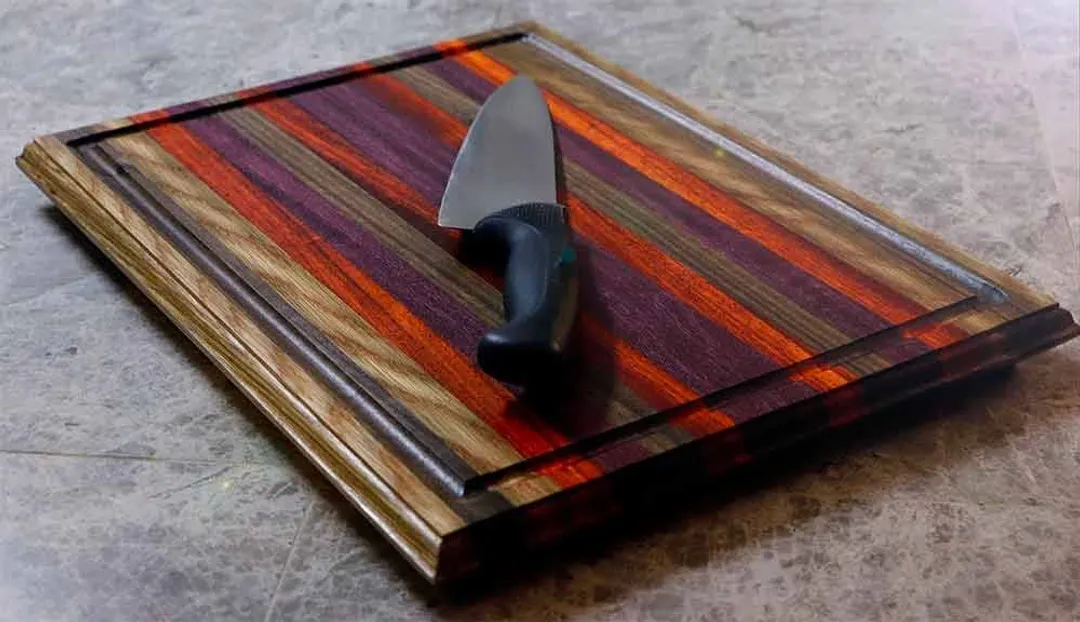
You can peruse this database of wood types, which contains essential information about each species’ different properties (including potential toxicity).
How to Clean Wooden Cutting Boards
Common Dish Soap
Common dish soap is okay for day-to-day washing after you’re done using the board.
First, rinse the whole board with warm water (don’t use scalding water as wood is relatively heat sensitive) and make sure to wash off any debris and residues from your work. After, lather the soap on all surfaces. If your board has any scratches or cracks, pay extra attention and rub the soap harder into them. Those are golden places for bacteria to grow and develop.
Use a soft sponge or a soft-bristle brush to scrub the board. Make sure to pay close attention while you’re scrubbing; if your sponge or brush creates micro-scratches on the board’s surface, stop immediately.
Make sure both sides of the board are cleaned evenly, don’t just focus on the up side. Meat juices can leak through the board and reach the other side, as well.
How to Sanitize a Wooden Cutting Board with Bleach
We recommend using bleach to clean your board after you prepare meat or poultry. This is a good way to decontaminate your board and avoid cross-contamination.
Fill up a large container with about one gallon of water and add one tablespoon of household bleach. Mix it until the bleach completely dissolves. Put the cutting board into the container (make sure it fully sinks into the solution) and allow the board to rest inside for about 5 minutes.
Fish it out once the time has elapsed, rinse it in tap water, and let it dry.
White Vinegar
If you don’t like the idea of using bleach, you can substitute it with white vinegar. Mix one part white vinegar with four parts water in a container, then let the board soak in the solution for 5 minutes. Rinse it off once finished and allow to dry.
Lemon and Salt
Surprisingly, to deep clean your board of debris, ingredient residue, and collected gunk, the method to use is all-natural: half a lemon and some coarse salt.
First, you need coarse salt, which means either unprocessed sea salt or kosher salt. Most types of table salt are too fine to be effective. As for the lemon, whichever type is fine. You can even use lime.
Sprinkle about a handful of salt onto the board and use half a lemon to scrub the salt across the board’s surface (using the fleshy part, of course). The coarse salt agitates the debris and gunk, lifting them off the board. Meanwhile, the lemon juice can take out stains as well as remove any unpleasant odors that the board may have developed during its use.
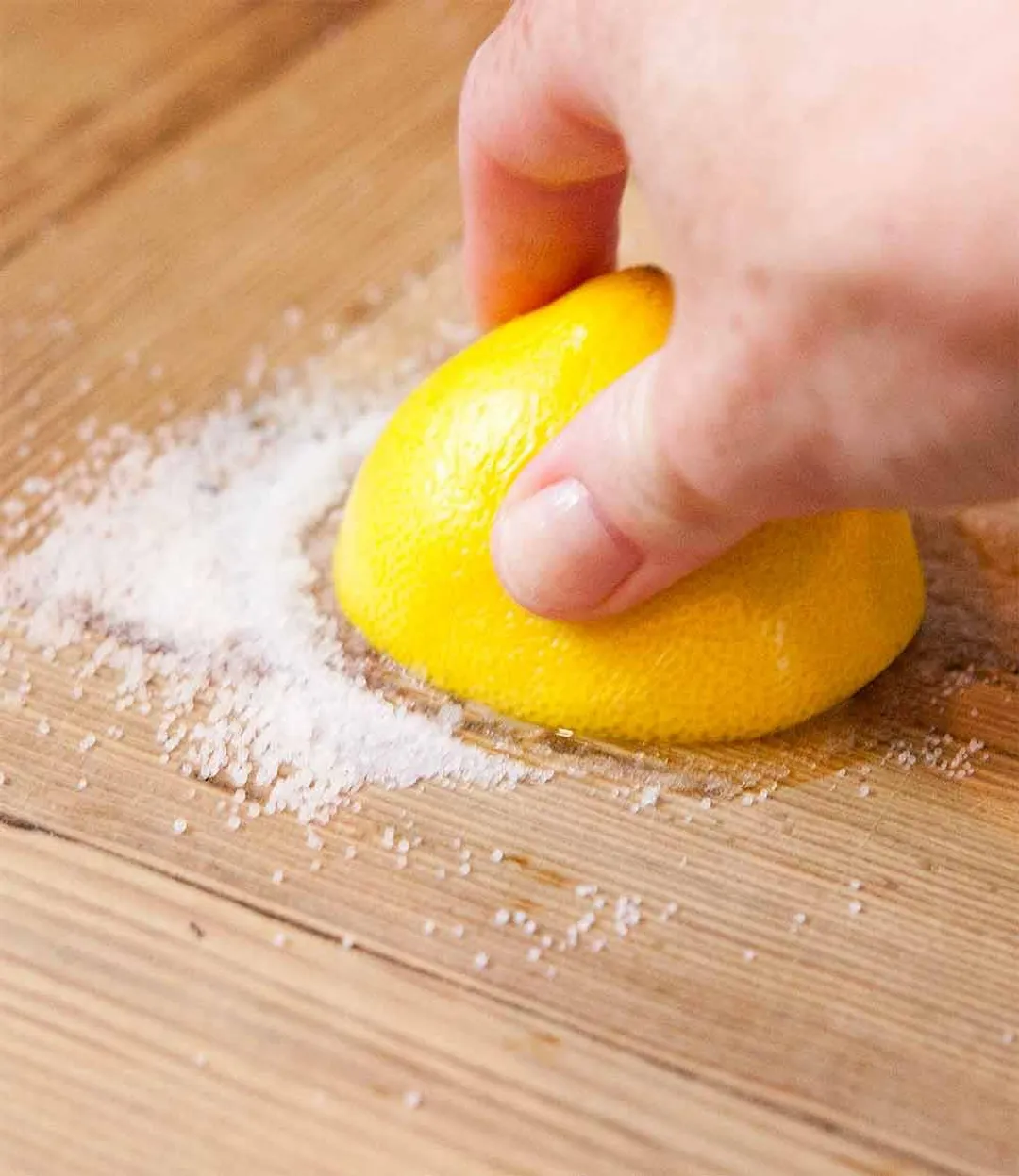
Once all of the visible messes and stains have been scrubbed out, let the salt-and-juice mixture sit atop the board for about 5 minutes. Then, rinse off everything with tap water and let the board fully dry before using again.
How to Oil a Cutting Board (Especially a Wooden One)
Conditioning your board monthly can cut down drastically on maintenance needs as well as prolong the lifespan of your board. Basically, this process entails applying a layer of mineral oil onto the wood. The oil will prevent the wood from becoming too dry, which would turn it brittle and prone to cracking and warping. It also seals up the wood and prevents water leakage.
The first step is to choose the type of oil.
Food-grade mineral oil is easy to find and inexpensive. But you can also choose admixtures of mineral oil and beeswax, which also have the additional property of renewing your board’s shine. If you want to go the “au naturel” route, you can use coconut oil, walnut oil, or almond oil. Although they’re natural ingredients, they won’t go rancid on your board.
Once you have the oil, make sure your board is completely clean and dry first. Because the oil will take some time to settle, we recommend doing this in the evening to let the oil sink in overnight.
The oil is completely safe to handle using bare hands. Just pour a bit onto the board, then lather it across the different surfaces of the board (front, sides, and back) with your palm. Wash your hands afterwards.

If you feel uncomfortable handling the oil, use an implement like a butter knife, a spoon, or a sponge.
In the morning, the oil will have dried. Use a towel to wipe off any excess. To ensure everything is clean, give the board a light wash under the faucet with soap.
Reapply the oil monthly or as needed.
What to Avoid While Cleaning Wooden Cutting Boards
Dishwasher
Do not put your wooden cutting board in the dishwasher. While some wood types can resist a decent amount of heat, the heat from a dishwasher can cause your board to warp.

Let It Soak in the Sink
Once again, wood does not play well with water and moisture. When you soak your board, make sure to fish it out after 5 minutes, no longer. Leaving the board for a long period of time in soapy water is a sure-fire way to tarnish your board.
How to Clean Bamboo Cutting Boards
Bamboo cutting boards have gained a lot of popularity recently. They offer virtually the same features as other wooden cutting boards: beautiful, tough, durable, and naturally antimicrobial. But the key factor lies in the fact that bamboo boards are more eco-friendly.
Compared to a maple tree that can take up to 15 years to reach maturity and a “harvestable” age, bamboo only needs 5-7 years. Thus, they’re considered much more renewable than traditional wood.
Fortunately, bamboo boards can be cleaned using all four of the aforementioned methods. Bamboo also cannot be put through the dishwasher and should not be left underwater for long periods of time.
How to Care for a Bamboo Cutting Board?
Bamboo boards, just like wooden ones, should also be conditioned. Many brands now have special “bamboo conditioner/protectant.” It’s unclear whether there are any extra ingredients in these products and how they make a difference compared to ordinary wood conditioners. Nonetheless, we still think you should consider conditioning your bamboo board with these just to be safe.
How to Clean Plastic Cutting Boards
The greatest allure to plastic cutting boards is they’re very cheap. As a result, most people typically don’t just have one plastic board lying around, rather having two or three. Having multiple cutting boards is recommended since it can drastically reduce the risk of cross-contamination. Use one for meat, and another for other foods.
But, of course, this could potentially make cleaning all of the boards a big issue if done by hand. Fortunately, plastic cutting boards are dishwasher safe. They’re cast from heat-resistant plastic, so, unlike wood or bamboo cutting boards, they can bear the heat of the dishwasher just fine.
Nonetheless, you should still use elbow grease from time to time. Though plastic cutting boards are highly heat resistant, repeated and frequent exposure to high temperature will eventually cause them to warp.

There are four manual cleaning methods you can use: dish soap, bleach, vinegar (for eliminating bad smells), or baking soda.
We’ve introduced all but the baking soda method, so we’ll go into further details for it.
In this method, you need to mix up a paste consisting of 1 teaspoon of baking soda, 1 teaspoon of salt, and 1 teaspoon of water. The result should have the same consistency as toothpaste.
The way to use it is similar to toothpaste, too: pour it onto a brush (preferably an unused toothbrush) and scrub the paste onto the board. The paste will help lift stains and clean other unsavory leftover debris from the surface.
You’ll find results to be especially notable on white plastic boards.
How to Clean Glass Cutting Boards
The biggest advantage of a glass cutting board is that it is completely non-porous. Glass does not stain, and it does not have pores to harbor bacteria, so you’ll have less to worry about while cleaning. Additionally, tempered glass (the type used to make most glass cutting boards) is heat resistant, so you can load it into the dishwasher as well.
The most grievous error that owners of glass cutting boards typically make is using household windows or glass cleaners such as Windex to sanitize the board. The temptation to use these products is understandable, but Windex and Fantastik are not food grade. It even says on the bottles that they’re not to be ingested.
Because of this, make sure you only use products that are certified non-toxic and ingestible. A good example is the Puracy All-Purpose Cleaner. It’s composed mostly of plant-based and biodegradable compounds. As a result, even if there are still traces of the solution left on the board after you’re finished cleaning, you won’t fall ill.
How to Clean Marble Cutting Boards
Marble, like glass, has risen in popularity recently due to its innate beauty. It’s also known to be a rather easy-to-clean material. You can use three of the common cleaning methods on marble (dish soap, diluted bleach, or vinegar).
But if you’re up to it, you can also make your own marble cleaning solution.
The ingredients include 1 cup of white vinegar (don’t substitute it for any other type, since white vinegar provides the best cleaning power) and 2 teaspoons of dish soap. Mix them together in a spray bottle with 2 cups of water. Spritz the solution onto the marble surface and use a sponge to rub it in. The white vinegar serves as a sanitizer, while the soap helps eliminate stains and other stuck-on residues.
Despite being a type of stone, marble is quite porous. Thus, your marble cutting board can easily develop stains. The solution we mentioned earlier should help ward them off, but in case they develop, you can use hydrogen peroxide paste.
This paste, composed of 1 teaspoon of hydrogen peroxide and baking soda (just enough to make a smooth paste) is a highly effective whitening agent.
Apply the paste onto the stained spots on the board. Once that’s done, wrap the board using plastic wrap and allow the paste to dry, which should take about a day. Wipe off the dried paste using a brush and check to see if the stain is still visible. If it is, reapply the paste and redo the entire process until you’re satisfied.
If you want to maintain your marble board’s shine, there are marble conditioners available for purchase.
How to Clean Stainless Steel Boards
Stainless steel cutting boards are the least fussy to maintain. You only need to clean it with dish soap and water daily. If you need to sanitize it, boil a tub of hot water and let the board soak (soaking stainless steel for long periods of time is not an issue).
Make sure never to let your stainless steel board come into contact with anything that has a high pH level, such as bleach (no matter how diluted) or alkaline cleaners. These will corrode the metal.
Conclusion
We hope this short guide has addressed all of your questions about how to clean cutting boards!
Authors
Luna Regina is an accomplished writer and author who dedicates her career to empowering home cooks and making cooking effortless for everyone. She is the founder of HealthyKitchen101.com and HealthyRecipes101.com, where she works with her team to develop easy, nutritious recipes and help aspiring cooks choose the right kitchen appliances.

